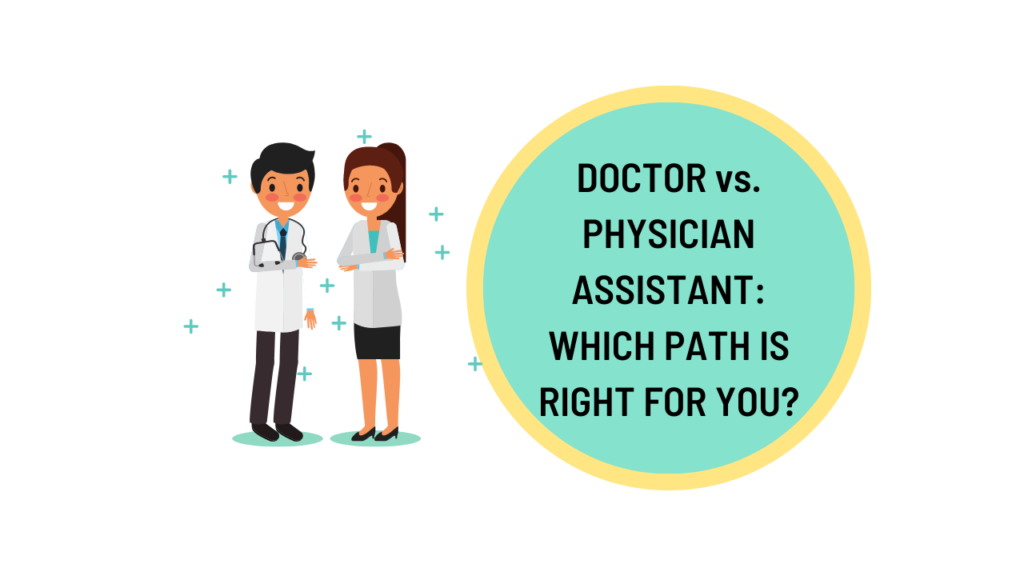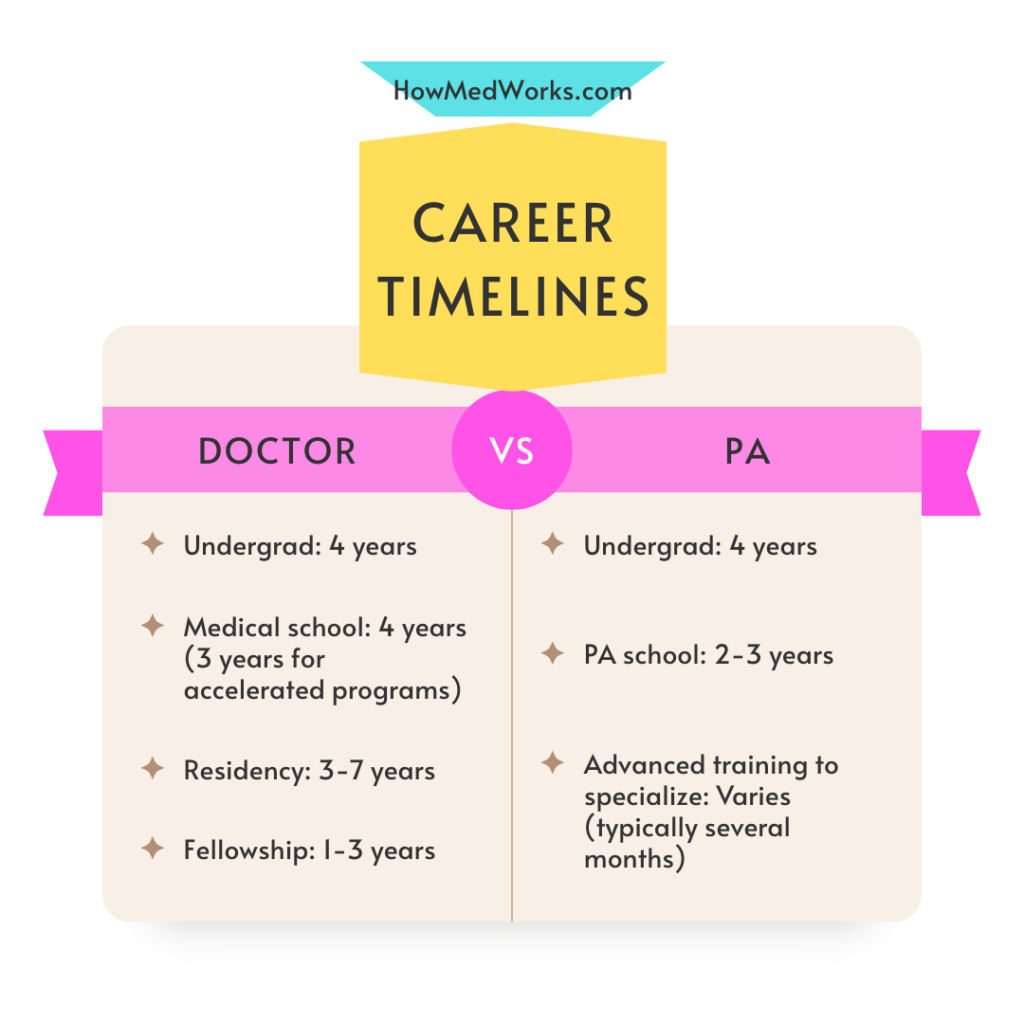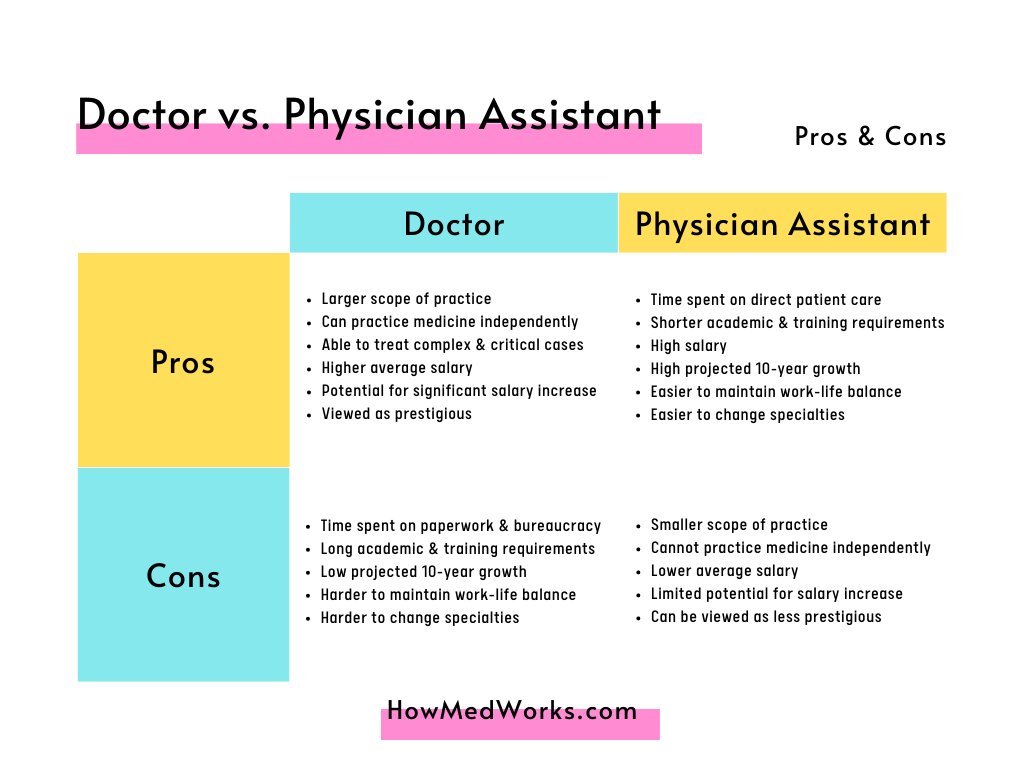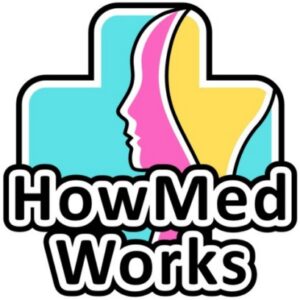
If you’ve come across this article, then you’re probably trying to figure out which career in healthcare is the right fit. Deciding to pursue a healthcare profession is a huge step so good for you! There’s a multitude of jobs in this field and deciding can be tough, but that’s what I’m here for. 😀
In this article, we’ll be discussing in detail the ins and outs of being a doctor and physician assistant – two healthcare professions that are compared a lot. First, I’ll give you an overview about what each one does. Then, we’ll go over the similarities and differences between a doctor and physician assistant. Lastly, I’ll be giving you my thoughts on which route you should pick. Let’s get started!
Table of Contents
Overview: What Is a Doctor?
A doctor, or physician, is a medical professional with an MD or DO degree who is licensed to practice medicine. Doctors diagnose and treat patients and are able to write prescriptions and perform surgeries. They work in different specialties and subspecialties and take the lead in patient care teams.
To become a doctor, you must successfully complete medical school, residency, and (for some) a fellowship. Additionally, you need to pass either the U.S. Medical Licensing Examination (USMLE ) or Comprehensive Osteopathic Medical Licensing Examination of the U.S. (COMLEX-USA
) or Comprehensive Osteopathic Medical Licensing Examination of the U.S. (COMLEX-USA ), which are three-part examinations to obtain a medical license. Finally, you’ll need to apply and be approved for one or more state licenses in order to practice medicine in a particular state or states.
), which are three-part examinations to obtain a medical license. Finally, you’ll need to apply and be approved for one or more state licenses in order to practice medicine in a particular state or states.
For a deep dive on the specific timeline and tests required to become a physician, check out my article “Jobs in Healthcare Series: What is a Doctor?” In it, I go over the different types of physicians, steps to become one, as well as the biggest pros and cons of the profession.
Overview: What Is a Physician Assistant?
A physician assistant (PA) – sometimes called a physician associate – is a medical professional with a Master of Science in Physician Assistant Studies who is licensed to practice medicine with doctor oversight. PAs work alongside doctors to diagnose and treat patients, help deliver more efficient care, and expand access to quality healthcare. They are able to prescribe some medications, perform minor procedures, and assist on major surgeries. PAs also work in a variety of specialties and subspecialties and are often responsible for the majority of direct patient care.
In order to become a PA, you must finish PA school and extra training if working in a specialty or subspecialty. PAs must pass the Physician Assistant National Certifying Exam (PANCE ), which is a five-hour-long test to become a certified physician assistant. The last step is to apply and get approved for a state license prior to working.
), which is a five-hour-long test to become a certified physician assistant. The last step is to apply and get approved for a state license prior to working.
Physician assistants are nationally-certified and state-licensed. If you want to know more specifics about the steps it takes to become a practicing physician assistant, take a look at my “Jobs in Healthcare Series: What is a Physician Assistant?” article. There, I go in detail on how to become a physician assistant, the roles and responsibilities of a PA, and the main advantages and disadvantages of the profession.
This is a table summarizing the exams, licenses, and certifications required to become a practicing physician assistant, as well as the physician equivalents:
| Doctor | Physician Assistant | Purpose | Required or Optional? |
| MCAT | GRE | Exam for medical school or PA school admissions | Required |
| USMLE (for MD) or COMLEX-USA (for DO) | PANCE | Exam to earn medical license | Required |
| Board certification | Board certification , specialty certification, and/or Certificate of Added Qualifications (CAQ) , specialty certification, and/or Certificate of Added Qualifications (CAQ) | Exam to demonstrates expertise in a specialty or subspecialty | Optional but highly recommended |
| State medical license | State license | Allows the doctor or PA to practice medicine in a specific state | Required |
What Are the Similarities and Differences Between a Doctor and Physician Assistant?
Similarities Between a Doctor & Physician Assistant
- Roles & Responsibilities
There is much overlap between what a doctor can do and what a physician assistant can do; both are medical professionals who are licensed to legally practice medicine and oversee patient health.
Here’s a list of what both a doctor and physician assistant can do:
- Conduct physical examinations
- Order and interpret labs, scans, and tests
- Diagnose and treat patients
- Develop treatment plans
- Prescribe medications
- Perform procedures
- Update patient medical charts
- Provide health counseling and education
You may be seen by only a doctor, only a PA, or both. The breakdown of responsibilities between the doctor and PA may be different, and this can be due to a variety of reasons (type of location, reason for seeking medical help, provider preference, scheduling, etc.). In any case, you should know that you are receiving care from professionals who have undergone extensive medical training. Moreover, both physicians and physician assistants must follow strict guidelines and regulations. These rules ensure that doctors and PAs are only doing what’s in their scope of practice and making recommendations based on their patients’ best interest.
- Education & Training
Medical school and PA school follow the same model and consist of rigorous education and training. More specifically, doctors and PAs follow a similar track that consists of a didactic phase for the first half and clinical phase for the second half. (This is opposed to the nursing route that registered nurses [RNs] and nurse practitioners [NPs] follow.) The didactic phase consists of schoolwork and tests. Later, during the clinical phase, students get supervised, hands-on training working with real patients in different medical locations.
- Extracurricular Pursuits
Both doctors and PAs can teach students, conduct research, and work in administration/management. These activities are not necessarily required for practicing doctors and PAs; however, many choose to do so outside of their clinical work (seeing patients).
Differences Between a Doctor & Physician Assistant
Much of what a physician does and PA does looks the same. However, there are some key differences to note.
- Level of Education
One of the biggest differences between doctors and PAs is the type of degree earned. After finishing medical school, doctors obtain a Doctor of Medicine (M.D.) or Doctor of Osteopathic Medicine (D.O.) degree. M.D. and D.O. degrees are doctorate-level, signifying the highest level of academic achievement in a particular field.
Contrastingly, physician assistants earn an M.S. (Master of Science) in Physician Assistant studies after completing PA school. As the name implies, this is a specialized Master’s degree that indicates extensive knowledge in PA studies – much of the material overlapping with what students learn in medical school. However, while a Master’s degree is above an undergraduate degree, it is below a doctorate degree.
Important note: There is an option for physician assistants to earn a doctorate-level degree. The Doctor of Medical Science (DMSc)
is a clinical doctorate degree solely for practicing physician assistants. In DMSc programs, PAs cover healthcare policy, theory, clinical practice, leadership, and research in order to enact greater change in the field of medicine.
- Length of Education & Training
The education and training required for doctors is significantly longer than that of physician assistants. Excluding undergrad, it typically takes seven years at the very least to become a practicing doctor. However, it normally only takes two to three years to become a practicing physician assistant. This is because medical school is longer than PA school, and doctors must complete residency and, oftentimes, a fellowship – adding several years.
Take a look at the typical medical school timeline vs. PA school timeline:

- Scope of Practice
Since doctors undergo longer education and training to earn a doctorate degree, they have the largest scope of practice and greatest responsibility of all healthcare professionals. Scope of practice refers to the range of activities and actions that a professional is legally allowed to perform.
A doctor can choose to be a generalist, specialist, or subspecialist. They can make autonomous decisions, perform major surgeries, and instruct the rest of the care team on how to proceed with patient care. Most importantly, doctors can practice medicine independently. This means that they can see and treat patients without supervision or collaboration with other healthcare professionals.
Fun fact: The only other position in healthcare that can practice independently is the nurse practitioner. Compared to physicians however, nurse practitioners are much more limited in what they are allowed to do in terms of patient care.
PAs have a smaller scope of practice than doctors. For instance, PAs are constrained in the types of medications they can prescribe; certain medications can only be prescribed by a doctor. Also, while PAs can perform minor procedures – such as injections, inserting chest tubes, suturing, etc. – and assist on surgeries, they typically cannot perform major surgeries alone. In certain cases or specialties, PAs can perform surgeries if legally and contractually allowed and with approval by the supervising physician .
.
Food for thought: PAs can later choose to become doctors. They would still need to apply to medical school and complete all the same steps (no shortcuts), but there have been PAs who have decided to make the switch decades into their career.
On the other hand, it is much more difficult for a doctor to switch to physician assistant, as counterintuitive as that may seem. This is because many (if not most) PA programs do not accept applications from individuals who have completed medical school.
- Ability to Practice Independently
The biggest difference between what a doctor can do versus what a PA can do is that doctors can practice medicine independently, while a PA cannot. In other words, a doctor can see and treat patients by themselves, but a PA is required to have a supervising physician. The supervising physician’s job is to direct and review work and records completed by the PA and other medical staff, double-check that medical practice is responsible, and ensure that patient care is up to professional and ethical standards.
completed by the PA and other medical staff, double-check that medical practice is responsible, and ensure that patient care is up to professional and ethical standards.
Overall, physician assistants tend to be more involved in clinical practice, while doctors take on more of a supervisory role and are brought on for critical cases. Because doctors have to take care of a copious amount of paperwork and administrative tasks, PAs usually spend more time interacting with and treating patients. You can think of PAs as being responsible for running the majority of direct patient care, while physicians are in charge of special cases and double-checking care plans at crucial points.
- Compensation
While both doctors and physician assistants are relatively generously compensated, doctors have the ability to earn much higher salaries. The average physician salary is somewhere between $163,908 and $201,918
and $201,918 , while the median physician assistant salary is around $115,390
, while the median physician assistant salary is around $115,390 . While you shouldn’t enter the healthcare industry with high compensation as your main motivation, these are important things to consider.
. While you shouldn’t enter the healthcare industry with high compensation as your main motivation, these are important things to consider.
Should I Become a Doctor or Physician Assistant?
Now is the part you’ve been waiting for. Is it better to become a doctor or a physician assistant? Both professions involve meaningful work, good compensation, and high personal satisfaction. The answer to this is it depends on what you’re specifically looking for in a career.
To start, here’s a table of the most important statistics to know regarding the physician and physician assistant professions:
| MD | DO | PA-C | |
| Average/Median Salary | $201,918 ** ** | $163,908 ** ** | $115,390 |
| Average Student Loan Debt | >$200,000 | >$200,000 | $100,000 – $200,000 |
| Projected Growth | 3% | 3% | 31.3% |
| Years of Training* | ≥6 years | ≥6 years | 2-3 years |
| Traditional or Emerging Field? | Traditional | Emerging | Emerging |
| Overall Satisfaction | 7.4/10#4 Best Healthcare Job | 7.4/10#4 Best Healthcare Job | 8.3/10#2 Best Healthcare Job |
**The average salary difference between MDs and DOs is mainly specialty-dependent, not degree-dependent. MDs tend to specialize more than DOs, resulting in higher salaries.
Now that you have an idea of some of the stats associated with these two career paths, here are the top factors you should consider when deciding whether to become a physician or physician assistant.
You Should Choose to Become a Doctor If…
Becoming a doctor may be the right fit for you if you value being in charge of patient care and having autonomy in your work. As a doctor, you go through the greatest amount of schooling and training out of all healthcare professions to have the greatest scope of practice and responsibility. Being a physician means you do not need to consult with any other healthcare professional before moving forward with patient care. You get to take the lead on cases, oversee the care team, and make important decisions and judgment calls when needed. Additionally, only doctors can take on the complex and critical cases, prescribe certain medications, and perform major surgeries.
As a doctor, you are a scientist and lifelong learner. This means that you look at the data and evidence when diagnosing patients and coming up with treatment plans. You are constantly learning in your career as new information is discovered, and it is your job to use your knowledge and skillset to provide the best patient care.
Doctors are also high-earners. Starting salaries are six figures, and doctors are able to specialize and increase their salaries several-fold. Furthermore, physician salaries tend to increase with time and experience. In addition to high compensation, being a physician also comes with good job security. An added bonus is that doctors are highly respected, and a doctor is generally viewed as a very prestigious career.
Keep in mind that money and prestige should not be the main reasons you’re considering this track. Being a doctor requires years of extremely hard work and sacrifices, since nearly all of your time will go towards school and studying. After all, people will be putting their trust in you, and you’re going to be responsible for patients’ lives. It’s not something to take lightly, as being a doctor is very stressful and demanding. Doctors’ schedules are often inflexible, consisting of long shifts and odd hours. Maintaining a healthy work-life balance is difficult, and burnout, anxiety, and depression are common. Therefore, you must be truly dedicated to the work to become a doctor.
Important note: It is difficult to switch specialties as a doctor. Switching specialties would require redoing residency and fellowship(s), which would take several years to complete.
You Should Choose to Become a Physician Assistant If…
Being a physician assistant might be best for you if helping patients directly and work flexibility are your top priorities. As a PA, you undergo rigorous training that focuses on clinical work and direct patient care so most of your responsibilities will involve face-to-face time with patients. PAs are vital for increasing patient accessibility to quality care and helping alleviate physician burnout, since PAs can do a lot of the work that doctors do. You’ll still enjoy a relatively large scope of practice and high level of autonomy in your work. (Having a supervising physician does not mean they are always with you, breathing down your neck.) Job security and growth are bonuses too. The projected employment growth for PA profession is greater than that for the physician profession by a significant margin (31.3% versus 3%
versus 3% !).
!).
The most important part of becoming a PA is that you’re able to spend the majority of your time working directly with patients. PAs are not as tied up with paperwork and administrative tasks as doctors are. As doctors take on more responsibilities (e.g. paperwork, oversight, bureaucracy), a lot of the tasks that were previously considered the doctor’s responsibility will be yours. Again, this includes, but is not limited to: conducting physical exams, ordering tests and imaging, diagnosing patients, creating treatment plans, and performing procedures. Because of all the time you spend interacting with patients, you’ll likely get to know patients better and actually see the impact you’re making.
Flexibility and work-life balance are also highly attractive factors of the physician assistant profession. The path to becoming a PA is much shorter than that of a physician, and there is just one big test to pass at the end of PA school, compared to the grueling, day-long, multi-part exams required of medical students. Physician assistants also have the luxury of being able to specialize in many areas and switch specialties relatively easily; retraining in a different specialty only takes months, as opposed to years for a physician. Lastly, PAs typically enjoy a more predictable schedule and less bureaucracy, resulting in better work-life balance.
With all that being said, there are some downsides to keep in mind about being a physician assistant. The big downside to being a PA is that you cannot practice medicine independently. Directly or indirectly, your work requires approval by your supervising physician, and you won’t be the one making final decisions, which can be frustrating. Additionally, you may be unsatisfied with your salary because even though you’re doing much of the same work as a doctor, you’ll be making less and will not likely see a significant increase in salary, even with time and experience. Lastly, the PA profession may be viewed by some as less prestigious than being a doctor, and you’ll probably be spending the rest of your life telling people that you’re a “physician assistant,” not a “physician’s assistant.”
To summarize, these are the main pros and cons of being a doctor and physician assistant:

Final Thoughts
As you can see, both the doctor and physician assistant fields are wonderful in their own ways, and pursuing either one is highly commendable. While there is much overlap between being a doctor and being a PA, there are significant differences. Hopefully now you have a thorough understanding of the two and can pick the best path for yourself! 😀 See you in my next article! Stay safe and keep learning.
